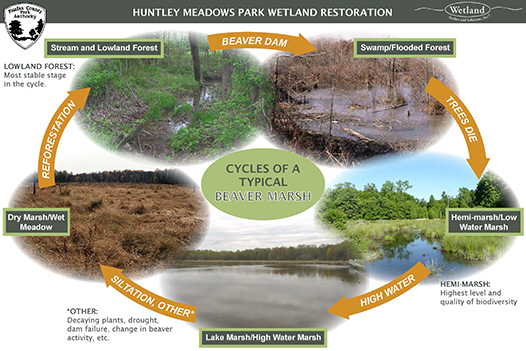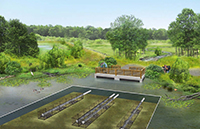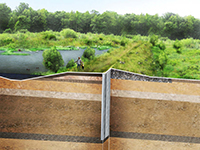
|
| Vol. 22, No. 1 |
March 11, 2014 |
|
|
Huntley Meadows Wetland Restoration
Wins Multiple County and Industry Awards
|
WSSI was recently named a National Recognition Award Winner in the 2014 Engineering Excellence Awards competition by the American Council of Engineering Companies (ACEC) for the design of the Huntley Meadows Wetland Restoration. Addtionally, the Huntley Meadows project received an Honor Award (Water Resources Category) from ACEC Metropolitan Washington (ACEC/MW), as well as the 2013 Fairfax County Tree Preservation Award and the 2013 Fairfax County Land Conservation Award: Best Protected Environmentally Site.
Project Overview
Huntley Meadows Park is a natural resource treasure located amongst the urban environment of Alexandria, VA. The site is a critical for migrating songbirds, waterfowl and a diversity of other birds along the Atlantic flyway, which stop to rest and replenish (or stay to nest) before continuing on their journeys. The central wetland area has been featured in National Geographic’s “Guide to Birding Hot Spots in the United States” magazine and was dubbed “the mid-atlantic coast region’s ranking freshwater marsh” by American Bird Magazine in 1989 when the wetland was in its prime condition as a hemi-marsh. However, the wetland has deteriorated over the past three decades due to consecutive droughts, siltation from upstream development north of the park, beaver activities, herbivorous feeding habits of resident Canada geese, and natural succession. These factors caused the wetland to transition to a lake marsh and eventually into a dry marsh/wet meadow (the wetlands existing condition).

Earlier efforts to develop a restoration plan were not accepted by all stakeholders and faced regulatory concerns with Fairfax County DPWES and the Virginia Department of Conservation and Recreation’s Dam Safety Division. Thus, when Wetland Studies and Solutions, Inc. (WSSI) was contracted by the Fairfax County Park Authority (FCPA) in 2011 to develop a restoration plan for this unique ecosystem, we were faced with the task of not only providing innovative engineering designs that solved a biological problem, but also winning over a skeptical contingent of involved stakeholders and providing a plan that was easily permittable.
Because there is an extremely limited amount of hemi-marsh in Northern Virginia due to historic development patterns, the FCPA decided to operate the park as a hemi-marsh system, which is known to have one of the highest levels of biodiversity and ecological function. The recreated hemi-marsh system contains roughly 50 percent open water and 50 percent vegetated wetland in the winter, with a summer draw down, and includes a woody component. Additionally, this system will provide: |
| 1)
|
Habitat for target plant and animal species (based upon FCPA studies) that were once
recorded at this wetland when it was functioning as a hemi-marsh system |
| 2) |
Reduction of invasive plant species and variation in the habitat quality for various animals |
| 3) |
Annual restoration of forage for a diversity of animals |
Innovative Engineering
 |
| Rendering of Clemson Water Levelers |
In order to create the hemi-marsh condition, it was necessary raise the permanent water surface elevation and to allow for the management of water levels, in a manner that mimics the predevelopment hydrology of the watershed and wetland area. To accomplish this, a water control structure (i.e., berm reinforced with vinyl sheet piling) and an outlet structure (containing the slide gates) have been constructed in the southern portion of the central wetland area. This has been designed to allow Park Authority Staff to adjust the water level within the wetland based on time of year and observed conditions.
 |
| Cross section of water control structure |
Only the top of the sheet pile wall is visible, flush with the ground, and will be further masked by the dense and diverse planting of native shrubs and herbaceous plant species. This has resulted in a permanent water control structure that will naturalize over time and will allow the environmental goals of the project to be met. Additionally, a wetland-plug has been installed to the east of the site to prevent drainage through an old drainage ditch and a permanent access trail has been constructed to provide access to the water control structures and impound high water levels. Several deep water habitat pools have also been excavated along with the construction of adjacent nesting islands within the central wetland area to improve the site’s diversity of habitat. All disturbed areas were seeded and planted with native vegetation.
Public Involvement
Due to the location of Huntley Meadows Park (within an urban environment) it was imperative that the design project was accepted by the public. Huntley Meadows Park receives approximately 200,000 visitors a year and conducts over 400 programs with 10,000 students every year. Along with the thousands of visitors, a non-profit organization (the Friends of Huntley Meadows Park), was created by individuals dedicated to the protection of the central wetland area (a place they refer to as “Fairfax County’s premier wetland wildlife sanctuary”). The more than 400 member group represents an active influential voice for the park.
WSSI’s innovative design was accepted by FCPA, the public, and the Friends of Huntley Meadows Park organization and has received positive reviews, such as this email from the organizer of the weekly birdwalk at the park on October 14, 2013, he writes: |
“I wanted to report to you all that the participants in this morning’s Huntley Meadows Monday Morning Birdwalk are very pleased at the outcome of the Huntley Meadows wetland restoration project. As you know, about 5 inches of rain fell late last week. This filled the central wetland area, giving our first view of what can be called the finished product. It was splendid! We had all studied the plans of the project, but it was this morning’s presentation that fit all the parts together. As the work began this past summer, some of the Huntley Meadows regulars became skeptical of the outcome of the project. Every Monday, we would hold our own informal program review from the boardwalk and the tower. Many photographs were taken and many amateur engineering assessments were made. But this morning we all agreed - it was well worth the anxiety. You have done a spectacular job, and have given us our park back in better shape than when we handed it over to you. Well done, all, and thank you.”
|
For more information on the Huntley Meadows Wetland Restoration project, please contact Mike Rolband, Jennifer Van Houten, or Frank Graziano.
An article and video on the Huntley Meadows Wetland Restoration have also been posted Fairfax County Park Authority’s ResOURces Newsletter. |
|
|
|
|
 |
|
|